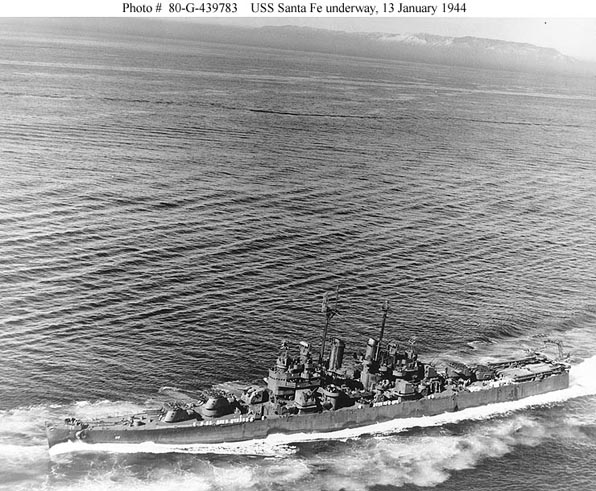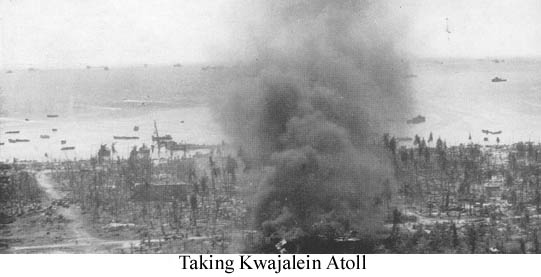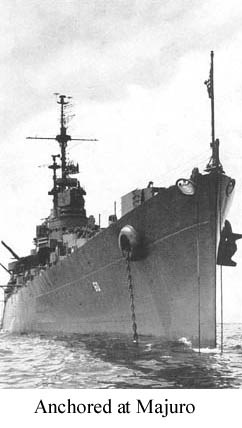|
Preparatory to air strikes on the northern Marshalls, cruisers SANTA FE and MOBILE joined Task Group 50.3 on 26 November, left the Tarawa area on the 28th, and sped northeast to rendezvous with a similar carrier and fueling group. Approaching Kwajalein Atoll from the north, the carriers began launching their planes at 0630 on 4 December. All day long the Navy planes pounded Kwajalein and neighboring Wotje, snagging several ships at anchor and a large number of aircraft on the fields. When the group began to retire shortly after sunset, the Imperial Air Force went into action. A flock of Japanese planes approached at 1846, lighting up the task group with flares. Before the last attacks were repelled at 0200 on 5 December, the SANTA FE had opened fire twice, scoring no hits either time. Task Group 50.3 was free of damage, but the carrier LEXINGTON in nearby "50.2" took a torpedo hit aft which disabled her steering gear. Together the two groups retired from the operation. New duties awaited veteran SANTA FE when she cruised into Pearl Harbor 9 December, also a new Commanding Officer. Captain Berkey was relieved 15 December 1943 by Captain Jerauld Wright, USN. Back in 1942, Captain Wright commanded the submarine which carried tall, angular Major General Mark W. Clark to North Africa. Clark's top secret mission consisted of consulting with non-Vichy French officers, paving the way for Operation Torch, i.e. , the Allied invasion of North Africa. SANTA FE left Pearl Harbor 28 December and proceeded singly to California to report for amphibious training. Depositing 275 passengers at the San Pedro Naval Base 1 January 1944, the vessel spent the next two days exercising in the San Clemente area, and ten more days rehearsing landings at Long, Beach.
With Task Force 53 (Northern Attach Force, commissioned to take Kwajalein), the SANTA FE left for the Hawaiians 13 January. On 21 January she took on fuel and ammunition and anchored at Lahaina Roads. Task Force 53 sortied the next day for the Marshall Islands. CL-60 was among a light force group detached on 29 January from Task Force 53 for the purpose of neutralizing Wotje in advance of the Kwajalein effort. From dawn of the 30th until 0822, the SANTA FE carried out a series of coastal runs while lacing Wotje's airstrips, seaplane hangars and dispersal areas. Heavy return fire from 6-inch shore batteries straddled the cruiser, and hit the destroyer preceding her. At noon the group rejoined Task Force 53 for the approach on Kwajalein.
January 31st 1944 was a big day for cannonading cruiser SANTA FE. Japanese installations on Roi one of the Kwajalein ring's low, sandy islands, were her objectives. Before the sun rose she guarded a flotilla of landing craft making entry into the eighty-mile-long lagoon. Then, at 0845, Captain Wright ordered his gunners to pitch in on the beach defenses on Roi's southern and western perimeter. Blockhouses and batteries were crushed by SANTA FE shells, which poured into the small island until 1500. A well-revetted double 5-inch mount offered the only return fire and USS SANTA FE smothered this emplacement before retiring with transports for the night. Major General Harry Schmidt's 4th Division Marines took bazookas and flame-throwers with them as they stormed Roi on the morning of 1 February. Cruiser SANTA FE shifted her position and began shooting up the northern half of the island. By evening the Marines were engaged in mopping-up operations. On 2 February 1944 the SANTA FE dropped her hook in the Roi anchorage. So overwhelming was American sea and air power in the Marshalls that Task Force 58, with several battleships and carriers, was ordered to make a carry-over foray against impregnable Truk in the Carolinas. Terminating a 30day tour with an escort carrier division (3-6 February), the SANTA FE went to newly-seized Majuro Atoll, then sallied to Truk on the 12th with the fast carriers. Throughout the 16th of February the U. S. Navy's wings roared out in vengeance at the big Caroline bastion. Although the bulk of the enemy fleet had gone elsewhere, many ships and scores of Japanese planes were destroyed before the Navy planes flew back to their carriers at sunset. Late that night the first enemy air attack was detected. Until 0215 the next morning, the SANTA FE and her partner units in the carrier screen were busy repelling low-level torpedo attacks. Only ship damaged was the carrier INTREPID, in a task group adjacent to the SANTA FE's, who drew a torpedo just after midnight. Air strikes were continued until noon of the 17th when Task Force 58 abandoned ravaged Truk. On the credit side of the Navy's ledger: 32 Japanese ships and 270 planes destroyed at Truk. On the debit side: 17 U.S. planes lost. In Tokyo there were bitter repercussions over the unpreparedness of Truk's garrison in the face of the daring American raid. Taut, bony Premier Hideki "The Razor" Tojo vigorously rattled his chain of command, dismissed his Army Chief of Staff, and took over the reins himself.
Cruiser SANTA FE stood into Espiritu Santo 12 March. Her task group sortied from that point on the 15th, skirted the Solomons, and covered the occupation of Emirau Island, north of New Britain, on the 20th. No resistance was met by the SANTA FE's force, which screened the first echelon as if retired from the uncontested Emirau landings, then guarded the second echelon during its approach. On 27 March the SANTA FE fueled and went back to shepherding the flat-tops. Heavy air attacks greeted her as she went on a sweep to the western Carolines with three carrier task groups. All of these were beaten off before any of her charges incurred hits. Palau was pounded 30 March, Yap on the 31st and Woleai on 1 April. Passing to the south of the Carolines the SANTA FE returned to Majuro 6 April 1944.
Still hanging on to the northern end of New Guinea's hog-backed coast from Madang to the Moluccas were some 60,000 Japanese troops, whom General MacArthur was now in a position to crush. Heavy air coverage and shore bombardment were to coordinate with MacArthur's troops in this final phase of the arduous New Guinea campaign. In company with Task Group 58.1, the SANTA FE departed Majuro on the evening of 13 April and headed southwest.
Radar controlled the SANTA FE's 6-inch guns as they opened up on Wake and vicinity at 1019, the 22nd of April. Upon completion of the bombardment, the cruisers resumed normal stations in the task group, which was then engaged in the second day of air support. On 23 April the ships fueled and returned to the Hollandia area, where they went unchallenged. On 26 April the task group moved eastward to replenish fuel and aircraft at Manus' Seeadler Harbor; then set out on a northerly course for Truk on the evening of 28 April 1944. Truk was plastered once on the 29th and again on the 30th with Admiral DuBose's cruisers standing by. Ponape got it skyward and seaward on the 1st of May when, in concert with the bombing, a fast battleship group carried out a thorough surface bombardment. Following this, the SANTA FE proceeded east with Task Group 58.1, anchored at Kwajalein 4 May 1944. |



 Skipper Wright and his light cruiser were right with the swift carrier task
group which punched its way through a night-long series of Japanese aerial
attacks 21-22 February to hit the Marianas. SANTA FE's gunnery department
chalked up its fourth kill when it got a twin-engine bomber heading straight for
the ship. Her engineering department also came in for its share of credit.
Anchoring at Majuro 26 February, the SANTA FE completed 100,000 engine miles in
the year since she left the U.S. east coast.
Skipper Wright and his light cruiser were right with the swift carrier task
group which punched its way through a night-long series of Japanese aerial
attacks 21-22 February to hit the Marianas. SANTA FE's gunnery department
chalked up its fourth kill when it got a twin-engine bomber heading straight for
the ship. Her engineering department also came in for its share of credit.
Anchoring at Majuro 26 February, the SANTA FE completed 100,000 engine miles in
the year since she left the U.S. east coast.
 While MacArthur's approach on the big base at Hollandia was proceeding
virtually uncontested, the SANTA FE's carriers launched strikes against
airfields at Wakde and Sawar. SANTA FE sailors rescued three survivors of a
Grumman torpedo bomber which crashed 90 miles west of Wakde on the afternoon of
the 21st. That night Cruiser Division 13 was temporarily released from Task
Group 58.1 and given the job of ham-stringing the Air Force as it geared to
repel the Hollandia push.
While MacArthur's approach on the big base at Hollandia was proceeding
virtually uncontested, the SANTA FE's carriers launched strikes against
airfields at Wakde and Sawar. SANTA FE sailors rescued three survivors of a
Grumman torpedo bomber which crashed 90 miles west of Wakde on the afternoon of
the 21st. That night Cruiser Division 13 was temporarily released from Task
Group 58.1 and given the job of ham-stringing the Air Force as it geared to
repel the Hollandia push.